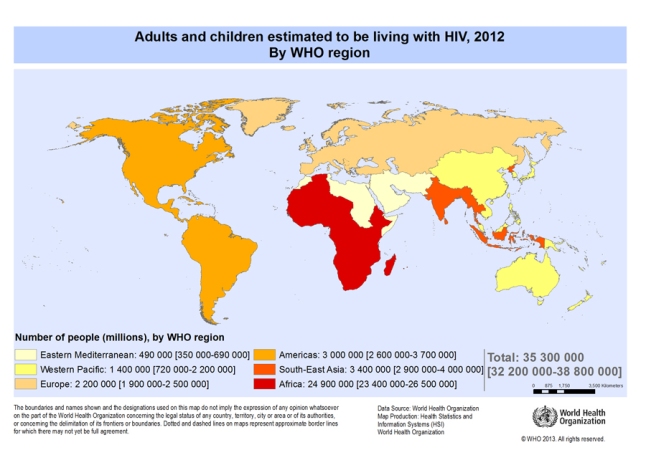Here’s a very brief overview of what HIV/AIDS is, who has it, who it effects, where it came from and where current research is going with it. Get reading!
Human Immunodeficiency Virus (HIV) is an incurable viral infection of the blood that leads to Acquired Immunodeficiency Syndrome (AIDS) in it’s most advanced form. The virus destroys or impairs immune cells in our body, weakening the immune system and causing sufferers to become susceptible to a wide range of infections and diseases that people with healthy immune systems can normally fight off. AIDS can take anywhere from 2-15 years to develop after initial infection and is defined clinically by manifestations of certain symptoms such as specific cancers or infections.
It is estimated that 35.3 million people live with HIV/AIDS and 69% of those are in Sub-Saharan Africa. Some don’t show symptoms at all, others maintain a good quality of life due to the effectiveness of antiretroviral treatment, and yet there are many that are ostracized from their communities and fall ill to opportunistic infections that they can’t shake and eventually cause death.
Today HIV/AIDS is one of the world’s largest threats to Global Health, consequently the United Nations set it’s sixth millennium development goal (MDG6) as “to combat HIV/AIDS, malaria, and other diseases”; they planned “to have halted and begun the reverse spread of HIV/AIDS by 2015”. HIV/AIDS is a global priority for researchers, clinicians, policy makers, social workers and funding agencies – many important worldwide organizations are involved.
There are two strains of HIV: HIV-1, the most common strain, is believed to be an evolved mutation of a Simian Immunodeficiency Virus (SIV) in Sub-Saharan Africa, passed from non-human primates to humans in the mid-1930’s and spreading epidemically in human populations worldwide since then, HIV-2 is more localized as it is less transmissible and mostly found in West Africa; Also believed to have passed from monkeys to humans, specifically the old-world monkey ‘Sooty Mangabey’ (Cercocebus atys).
HIV/AIDS was discovered in 1981, and since then a lot has been discovered about the pathology, and immunological and clinical aspects of the infection as well as the structural biology of the virus. Current research is focusing on the search for biomarkers of infection, transmission and progression of the disease, and the search for a universal anti-HIV vaccine. It is interesting to note that genetic contributions can be very significant, for example some patients can be exposed and remain uninfected (exposed uninfected/EU), and some can have the virus but not progress to AIDS (long-term non-progressor/LTNP).

The darker the region the more densely infected the population is. One in five adults is thought to be HIV positive in Sub-Saharan Africa.
Sources
1. Global Health Topics. HIV/AIDS [Internet]. U S Department of Health and Human Services; [cited 2014 Mar 30]. Available from: http://www.globalhealth.gov/global-health-topics/communicable-diseases/hiv-aids/
2. World Health Organisation. HIV/AIDS [Internet]. World Health Organisation – Health Topics; [cited 2014 Mar 30]. Available from: http://www.who.int/topics/hiv_aids/en/
3. Kaur G, Mehra N. Genetic determinants of HIV-1 infection and progression to AIDS: susceptibility to HIV infection. Tissue Antigens. 2009;73(4):289-301.